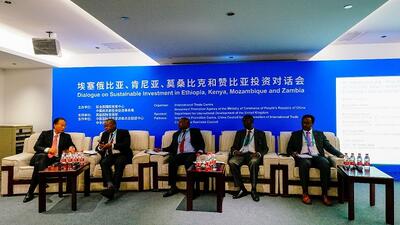Ethiopia is well positioned to become the textile and apparel manufacturing hub of Africa (en)
On 19 November, the International Trade Centre (ITC) organized, under the Partnership for Investment and Growth in Africa (PIGA) project, a dialogue on Ethiopia’s potential to become the next textile and apparel (T&A) supply base for the world. The discussion was organized in collaboration with the Ethiopian Investment Commission (EIC) and the China Chamber of Commerce for Import and Export of Textile and Apparel (CCCT).
The event gathered more than 100 international buyers, potential Chinese investors, representatives of Chinese and foreign-owned companies in Ethiopia and representatives of Ethiopian institutions. It was followed by field visits to T&A factories in several industrial parks around Addis Ababa.
Several advantages to become a world textile manufacturing hub
Despite challenges to overcome, such as reliable energy supply, customs procedures, lack of backward linkages and insufficient skills, all participants agreed that Ethiopia could become one of the next textile manufacturing hubs of the world with its wide and young labour pool, growing market potential, advantageous trade agreements, including the future African Continental Free Trade Area (AfCFTA), and strategic position.
Mr. Zhang Xi’an, the Vice President of the China Chamber of Commerce for Import and Export of Textile and Apparel (CCCT), explained, “I led several missions of potential Chinese investors to Ethiopia in recent years and witnessed the great progress made in the development of the industry. I believe Ethiopia can become an important T&A manufacturing hub.”
“If Ethiopia manages to solve its power issue, it has the potential to become a key T&A supplying hub,” added Mr. Neil Hackett, Edinburgh Woollen Mill Ltd. Group Managing Director for Sourcing & Supply Chain.
“We now have an office in Ethiopia and we are aiming for long-term development,” said Mr. Anas Tazi, Country Leader for Decathlon in Ethiopia.
Mr. Arwin Ludiansyah, Country Controller of H&M Ethiopia Production Office, pointed out that, “Ethiopia may be able to develop the sector more quickly than other countries have in the past because of technological advancement and lesson learning.”
The government has also prioritized the development of this sector, set up the Ethiopian Textile Industry Development Institute (ETIDI) to strengthen the overall value chain, and created a conducive investment climate for the sector. These efforts have been acknowledged by all participants, even though the above outlined challenges remain to be solved.
Sustainable investments are key for the sector’s development
All stakeholders emphasized the role of foreign direct investment (FDI) in leveraging this potential and the importance of attracting sustainable investments that comply with social and environmental standards.
Mr. Goshu Negash, President of the Ethiopian Textile and Garment Manufacturers Association, explained, “The T&A sector stagnated for many years, but it has been growing rapidly in the recent years, mostly due to foreign investors. The CMT (cut, make and trim) purchasing model can only be a stepping stone for the sector’s growth.”
“Chinese investment has contributed to the growth of the sector through knowledge and technology transfer, closing local companies’ capital gap and opening up new markets, and the government is looking forward to working with more Chinese investors and international buyers to further develop the sector,” added Mr. Sileshi Lemma, the Director General of the Ethiopian Textile Industry Development Institute (ETIDI).
Underlining the magnitude of Chinese investment in Ethiopia, which makes up 60% of overall FDI in the country during the last two decades, His Excellency the Ambassador Tan Jian advised, “The Ethiopian Government should focus on addressing the concerns of existing investors, because they will talk to other potential investors about the business environment and will influence their investment projects.”
Mr. Temesgen Tilahun, Deputy Commissioner of EIC, emphasised, “Attracting sustainable investment is at the heart of our efforts to attract and benefit from foreign investment. We want investment that generates inclusive growth without generating irreversible destruction to the environment and resulting in unsustainable development.”
International buyers are looking for suppliers who comply with sustainability standards
“With end customers and millennials requesting increased transparency and traceability on products purchased, implementing sustainable practices is not an option, but a no-brainer,” explained an international buyer.
“We are aware that companies sometimes need time and support to understand and implement these standards, but we are willing to support them in this process.”
The sustainable investment handbook developed by PIGA to guide investors on how to incorporate sustainable practices into their investment journey was, therefore, very well received, as it gives concrete guidance on which social and environmental regulations investors need to comply with, where to seek support and which additional sustainability measures could be implemented.
Mr. Temesgen explained, “We are confident that investors will find these guidelines useful to their efforts in making socially and environmentally responsible investments. EIC management and staff are ready to respond to investors seeking clarification.”
Decisive progress on T&A investment projects
Along with the fruitful discussions, the event enabled PIGA to make progress on three investment projects in Ethiopia’s textile sector. The projects, worth approximately $100 million, have the potential to create an estimated 10,000 jobs, mostly for young women. These projects should materialize in the coming months.
The Partnership for Investment and Growth in Africa (PIGA) is part of Invest Africa (IA), a flagship programme of the United Kingdom of Great Britain and Northern Ireland’s Department for International Development (DFID) facilitating foreign direct investment with high development impact into selected African countries.
Under IA, PIGA aims to contribute to job creation and sustainable growth in Ethiopia, Kenya, Mozambique and Zambia by supporting these countries to attract foreign direct investment, specifically Chinese investment, in the agro-processing and light manufacturing sectors. PIGA is also designed to enhance the capacity of these countries for effective investment promotion.
PIGA is implemented by the International Trade Centre (ITC) in cooperation with the China Council for the Promotion of International Trade (CCPIT) and the China–Africa Development Fund (CADFund).














